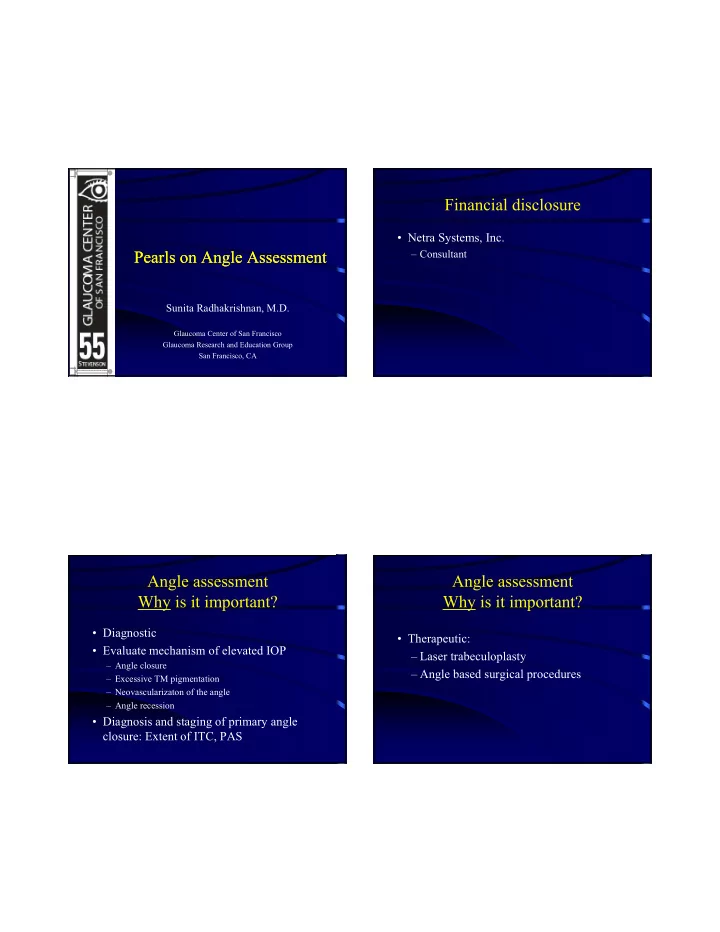

Financial disclosure • Netra Systems, Inc. Pearls on Angle Assessment Pearls on Angle Assessment – Consultant Sunita Radhakrishnan, M.D. Glaucoma Center of San Francisco Glaucoma Research and Education Group San Francisco, CA Angle assessment Angle assessment Why is it important? Why is it important? • Diagnostic • Therapeutic: • Evaluate mechanism of elevated IOP – Laser trabeculoplasty – Angle closure – Angle based surgical procedures – Excessive TM pigmentation – Neovascularizaton of the angle – Angle recession • Diagnosis and staging of primary angle closure: Extent of ITC, PAS
Angle assessment – How? • van Herick method? – Quick – Easy to use Definitions of angle closure By Van Herick: Grade 1 or 2 = closed By Gonioscopy: PTM not visible for at least 180 • Both VH and gonio by single glaucoma specialist • 14% of eyes with ITC of at least 180 were classified Observer Sensitivity Specificity as ‘deep’ on VH testing • Risk of misdiagnosis higher in Technician 58% 89% – PAC and PACG (versus PACS) Resident 79% 88% – Males Attending 68% 88% – Black or Asian race – Myopes
Gonioscopy Gonioscopy Angle Assessment – How? • Indirect assessment with van Herick can miss angle closure • Quick, 360° angle Assessment • Patients with deep AC and no obvious glaucoma risk factors can have angle pathology • Indentation possible –PAS, plateau configuration • Can detect causes of elevated IOP such as pigment dispersion, recession Direct visualization of the angle is the best way to assess Gonioscopy – Who is a candidate? • Every glaucoma suspect • Every patient with glaucoma • Consider gonioscopy for every patient at least once CLINIC-BASED OPPORTUNISTIC SCREENING
̵ Angle assessment – Who is a candidate? Angle Assessment – What should POPULATION BASED SCREENING you look for? • Gonioscopy requires specialized equipment and personnel SCLERAL SPUR • Angle imaging for detection of angle closure does not have high enough specificity Gonioscopy Jan 2015 • First locate the Scleral Spur • If not visible, look in a different quadrant May need to tilt goniolens • If still not visible, indent
What to look for? Gonioscopy in Laser Trabeculoplasty • What angle structures are visible? • Profile of peripheral iris – Convex / Flat / Concave • Degree of TM pigmentation SLT ALT • Abnormal findings – Excessive TM pigment, PAS, Abnormal blood vessels, Inflammatory nodules, Foreign bodies Intraoperative gonioscopy https://www.aao.org/clinical- video/intraoperative-gonioscopy • Surgical goniolens (mostly direct lenses) • Microscope is tilted 30 degrees toward the surgeon and the patient’s head is tilted 30-40 degrees away from the surgeon • Coupling agent on cornea • Working distance increases Courtesy: Glaukos, Istent Implantation Procedure 2010
Limitations of gonioscopy Angle assessment – How else? • Subjective • Anterior segment imaging • Requires highly skilled observer – Provides valuable cross-sectional information • Potential sources of error • Anterior segment OCT – Illumination • Ultrasound biomicroscopy – Contact Enhanced Anterior Segment Single Scan Anterior segment OCT Non contact Allows angle assessment in dark Entire AC in one scan Cannot image posterior to the iris Well-centered Visante ASOCT image with central reflex saturation beam visible and no lid or eyelash artifacts
High Res Corneal Scan Cornea Scleral spur Ant lens capsule Iris pigment Ciliary body epithelium Optovue Avanti ~ 830nm Anterior segment imaging with fourier domain OCT • Retinal OCT devices Spectralis 870 nm – Optovue – Cirrus – Spectralis • Dedicated anterior segment OCT devices – Tomey Cirrus 840nm
Cirrus OCT anterior segment Ultrasound biomicroscopy external lens kit Excellent visualization posterior to iris Requires immersion system Highly trained examiner Scleral spur Angle Assessment in my practice • Gonioscopy is the primary method – Sussman lens – Perform in every patient on initial examination – Perform periodically in phakic patients
How I use anterior segment imaging How I use anterior segment imaging • Adjunct to gonioscopy • Patient education – Understand the mechanisms of primary and • Angle assessment when gonioscopy is secondary angle closure not possible – No view/poor patient cooperation How I use imaging devices Conclusions • Gonioscopy is the primary method for angle • OCT first line device in most cases assessment and is important for diagnostic due to ease of use and patient comfort and therapeutic purposes • UBM when assessment of structures • Imaging devices are a useful adjunct posterior to iris is required – Can provide unique information useful in clarifying pathogenesis of primary and secondary angle closure
Recommend
More recommend